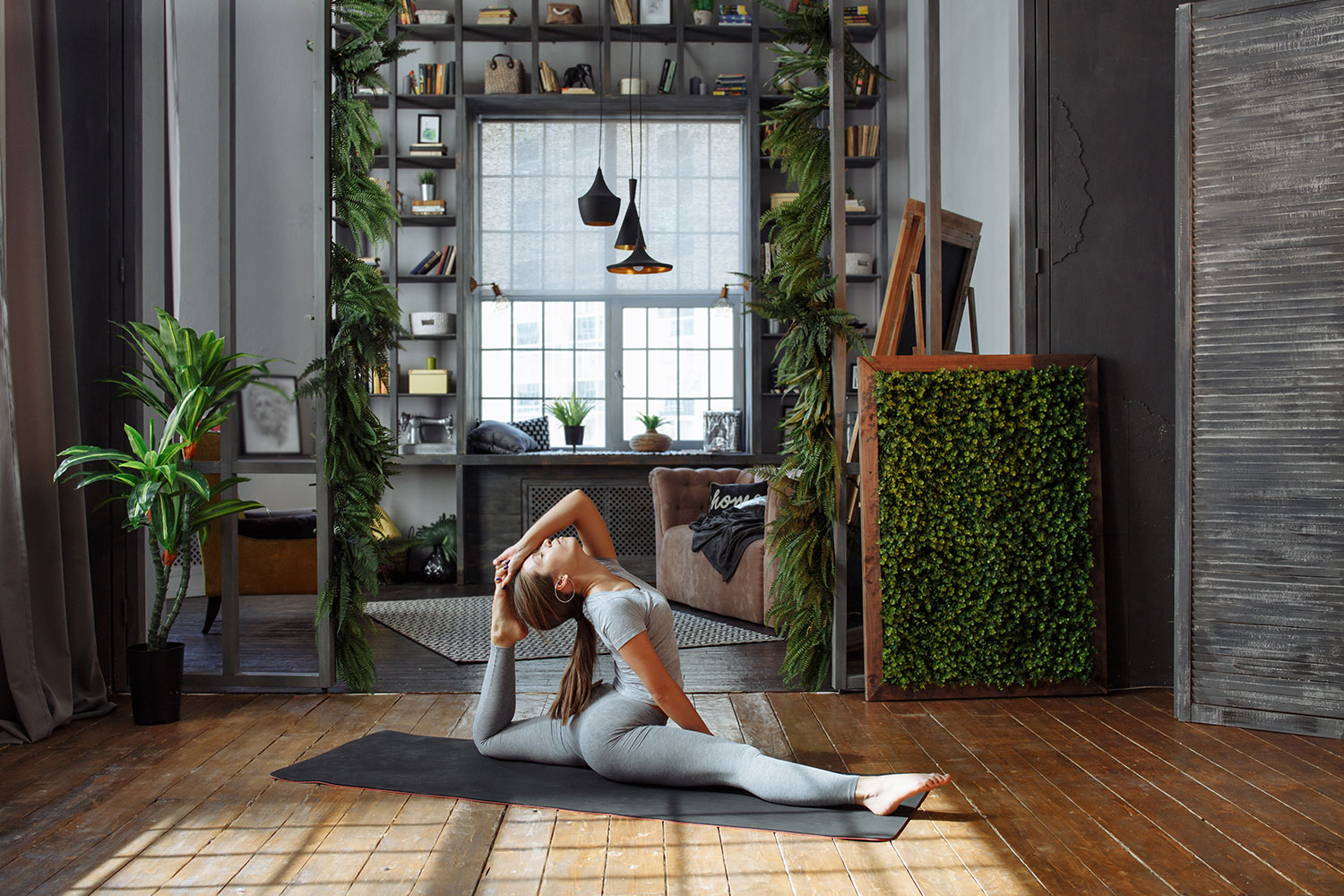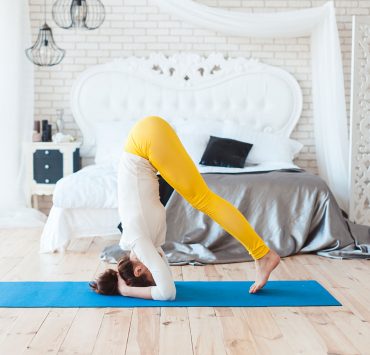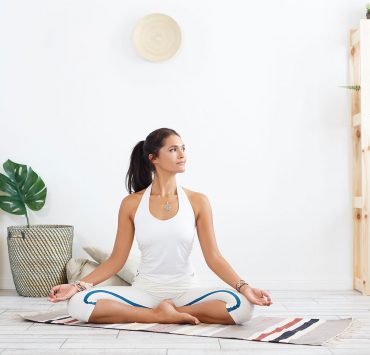
Rose graduated with a degree in Anthropology, which takes her…
One of the best ways to deepen your yoga practice is to start practicing yoga at home. Many yogis refer to this as a ‘home practice,’ and it is one of the most accessible and best ways to practice yoga. Despite how simple it may seem to practice at home, there are many barriers to beginning a home yoga practice. Most of these barriers exist within the yogi her or himself, though. Whether it is a lack of basic knowledge, fear of practicing alone, home distractions, resistance to forming a habit, or even becoming overwhelmed from the vast amount of online yoga resources, there are many challenges to starting a home practice. However, with a little forward planning and dedication, most of these challenges can be overcome. In time, a home practice will lead to myriad benefits for the yogi, both physically and mentally.
Why Start a Home Yoga Practice?

There are so many reasons to start a home yoga practice, from the accessibility of it, the financial advantage of not paying for classes, to more internal benefits such as mindfulness and stress relief. Furthermore, starting a home yoga practice doesn’t mean that the yogi has to quit going to public classes. The guidance from a certified teacher, combined with a sangha, or community, is wonderful and should be continued. However, consider yoga as a child learning a musical instrument such as piano. The child may go to piano lessons, but they will not advance if they don’t make the time to practice piano at home each week. The same is true with yoga, yet the advancements are not limited to the physical asanas (poses), but also the internal spiritual journey.
The benefits of a home yoga practice are exemplified in one 2012 study. In this study, the researchers examined over 1,000 survey responses from Iyengar yoga practitioners about their yoga practice and their health. What they found was surprising to some in the yoga community. Neither the frequency of yoga classes attended, or the number of years the participant practiced yoga were as good at predicting health as whether the participant had a home yoga practice. In short, a home yoga practice is associated with better health.
Increase Your Mindfulness

Yoga of all kinds can help a person develop mindfulness. What is mindfulness? It is the ability to separate feelings and ego from the true self, and observe the present moment with equanimity. Yoga teaches this by asking yogis to not only breathe, but to find peace in difficult physical postures. During these postures, the yogi learns about their mind’s own habits and patterns, and with time develops mindfulness. A home yoga practice can increase mindfulness through the same pattern that a yoga class can – the benefit is that a home yoga practice can introduce mindfulness in a new environment.
Become More in Tune with Your Body

Another benefit of a home yoga practice is becoming more in tune with your own body. Of course, all types of yoga teach body awareness to an extent, but a home practice heightens this experience. As renowned yoga teacher Rodney Yee states,
At home, you learn to listen to what your body needs that day, move at your own pace, and develop intuition about what sequences or kinds of yoga poses you want and need to do most on any given day.
By practicing yoga at home, the yogi can practice immediately upon waking up, and tune into how their body feels that morning. Alternatively, they can practice at the end of a long day and acknowledge how the day has left them physically and emotionally. The flexibility of a home practice means that the yogi chooses each pose for themselves: this decision-making responsibility will become honed over time as the yogi builds body intuition. Furthermore, the privacy and intimacy of a home yoga practice mirrors the body as a home in itself.
Sleep Better

There is more than just anecdotal evidence that yoga can promote better sleep. In one recent survey study, it was found that the majority of survey respondents said yoga helped them sleep better. Some researchers believe that this improved sleep is due to the use of pranayama (breathing techniques) that are integral to yoga, and which can modulate the parasympathetic nervous system and the body’s stress response. A home yoga practice may promote better sleep more than other forms of practicing yoga, purely because yoga can be practiced immediately before bed. There are many restorative yoga poses that can be practiced before (or even in) bed, such as reclined bound angle pose, bridge pose, child’s pose, and more. A few simple bed time yoga poses could be all it takes for a better night’s sleep, and the beginning of a home yoga practice.
Improve Your Self Motivation

There are many people who practice yoga for years but struggle in developing a home yoga practice. This is not for lack of interest, love, or advancement in level. The major stumbling block for many people in developing a home yoga practice is motivation. It takes a lot of motivation to come home and roll out a mat for a home practice, rather than lounging on the couch watching TV. However, by making a home yoga practice a habit, this will not only improve motivation in relation to yoga, but it will have rippling effects through other areas of a person’s life.
Let Go of Material Things

Another stumbling block to developing a home yoga practice is the perception that many items are needed. Some people are led to believe they need a certain fancy mat, expensive yoga clothes, props, blocks, straps, mirrors, and more in order to have a home practice. This couldn’t be further from the truth. While a mat is definitely useful, all a person really needs is their own spirit and willingness in order to practice yoga.
‘You can practice anywhere you wish for any amount of time—you can practice while you are standing in line at the grocery store, waiting in traffic, in a parking lot, on top of a mountain–there are so many places you can practice, and the best part is, it’s contagious! Chelsey Gribbon
Once the yogi is able to embrace the concept of yoga as a philosophical, holistic, eight-limbed practice, rather than something purely physical, they open themselves up to more opportunities, such as a home practice. In turn, by letting go of material things and expectations, they engage in aparigraha, which is one of the yoga yamas (or moral guidelines) meaning ‘non-attachment’ or ‘non-grasping.’
Focus on Yourself

One of the best reasons to start a home yoga practice is to give yourself some time to focus on your own wants, needs, desires, wellbeing, and more. So much of a person’s day is spent focusing on the external: whether it is work requirements, the traffic while driving, caring for family, and more. A home yoga practice gives the yogi the opportunity to self-indulgently choose their own poses, based purely on their own body and mind and not meant to please anyone else. It lets the yogi enjoy this time purely for themselves and bring some internal focus to what might otherwise be a hectic day.
It’s Convenient

An undeniable benefit of a home yoga practice is its convenience. In comparison to attending classes at a studio or gym, a home practice is more convenient in terms of travel, time, and finances. It is much easier to roll out a yoga mat on the living room floor than it is to get in a car, drive 20 minutes to arrive at a studio, and shell out $15 for a class that may or may not be suited to your body and mind space on that day, and then drive another 20 minutes home. Certainly, there are benefits to attending studio classes, such as the education and social environment, but when it comes to convenience nothing beats a home practice. Additionally, with so many online classes and sequences curated by yoga teachers nowadays, yoga is becoming much more accessible to all levels of yogis who want to practice at home.
Build a Foundation for Your Yoga Practice

Another reason to practice yoga at home is to build a steady, reliable foundation for your yoga practice in general. Sometimes in a group yoga class it can be intimidating to try new poses or advance familiar postures. Whether it is the fear of falling, or just not having enough time to devote to the more advanced poses during an hour long class, it is not always possible to truly learn a yoga pose if it is only practiced in public class. A home practice gives time for the yogi to experiment and play, and to challenge themselves in their own time.
Quit Comparing Yourself to Other People

Yoga teaches the importance of living in the present moment, letting go of expectations or desires (aparigraha), and releasing the ego. Ego is the identification with external goals, possessions, or status. And in a yoga class, ego inevitably leads to comparison with the other yogis. Many people struggle with comparison at some point in their relationship with yoga. If this is triggering, a home yoga practice is the perfect solution. Practicing yoga at home, alone, allows the yogi to escape from comparison with others, and give themselves time to overcome this issue and let go of their ego.
Create a Daily Wellness Routine

A final reason to devote yourself to a home yoga practice is that it is an easy way to bring a bit of wellness into every day. Most people thrive on routines, particularly at home. Whether it is a morning routine, a bed time routine, a meal prep routine, a chores routine, or more, the home space is full of routines. However, most of these routines are superficial or sources of stress. Introducing a sacred corner of the home devoted to yoga practice can create a different kind of routine: one of wellness, self-care, and self-exploration. As international yoga teacher Jason Crandall states,
A lot of students in their minds set themselves up for failure in their home practice because they think that it has to replicate or repeat the exact same experience as a yoga class. You want to just develop a simple routine that is warm and satisfying to you. Jason Crandall
The home yoga practice does not have to be complicated, last a certain period of time, or require expensive materials. It can be something simple and personal. The important part is that it is achievable and a regular commitment.
Risks of a Home Yoga Practice

A home yoga practice gives the opportunity for both introspection and privacy, because there is only one person practicing: yourself. However, this can also be a negative to a home yoga practice. Because there is no teacher present, the yogi’s risks are twofold. First of all, they risk injury, particularly if they are practicing advanced poses or do not have a foundational knowledge in yoga gained from a certified teacher. Without someone to guide them or correct them, injury is much more likely at home. Second of all, practicing at home also creates the risk of stagnation. Many people like to get in their habits, practice the poses that feel good in their body, and finish with that. A teacher’s role is not only to keep students safe, but to educate them and challenge them, showing them new poses, new transitions, and new perspectives on yoga philosophy.
Conclusion
Although there are so many benefits to a home yoga practice, it is ideal to continue practicing in public classes. A good balance of both will lead to the education and foundational knowledge from public classes, as well as the motivation, internal focus, and more that home practices allow. There are barriers and challenges to beginning a home yoga practice. Whether it is time, fear, ego, or more, people spend years wanting to begin a home yoga practice but not taking the first steps. It may be difficult to develop a home practice at first, but it is well worth it for the spiritual, emotional, and physical investment that it allows.
What's Your Reaction?
Rose graduated with a degree in Anthropology, which takes her understanding of basic human needs to a whole new level. Her intelligence and passion for healthy living is reflected in her written work.














